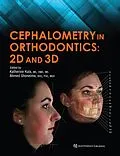Leseprobe
1
Introduction to the Use of Cephalometrics
Katherine Kula, MS, DMD, MS
Ahmed Ghoneima, BDS, PhD, MSD
Cephalometrics refers to the quantitative evaluation of cephalograms, or the measuring and comparison of hard and soft tissue structures on craniofacial radiographs. It is an evolving science and art that has been woven into orthodontics and the treatment of patients. Cephalograms are an integral part of orthodontic records and are typically used for almost all orthodontic patients. The cephalometric analysis or evaluation helps to confirm or clarify the clinical evaluation of the patient and provide additional information for decisions concerning treatment.
The American Association of Orthodontists (AAO) developed the current Clinical Practice Guidelines for Orthodontics and Dentofacial Orthopedics,1 which recommend that initial orthodontic records include examination notes, intraoral and extraoral images, diagnostic casts (stone or digital), and radiographic images. These radiographic images include appropriate intraoral radiographs and/or a panoramic radiograph as well as cephalometric radiographs. A three-dimensional cone beam computed tomograph (3D CBCT) can be substituted for a cephalometric radiograph; however, the routine use of a CBCT is not generally required in orthodontics, so cephalometric radiographs are the current standard.
The AAO Clinical Practice Guidelines1 also recommend evaluating the patient's treatment outcome and determining the efficacy of treatment modalities by comparing posttreatment records with pretreatment records. Posttreatment records may include dental casts; extraoral and intraoral images (either conventional or digital, still or video); and intraoral, panoramic, and/or cephalometric radiographs depending on the type of treatment and other factors. Many orthodontists also take progress cephalograms to determine if treatment is progressing as expected. In addition, board certification with the American Board of Orthodontics requires cephalograms and an understanding of cephalometry to explain the decisions for diagnosis, treatment, and the effects of growth and orthodontic treatment. Therefore, it is paramount that orthodontists understand how to use cephalometrics in their practice.
Basics of Cephalometrics
Cephalometrics is used to assist in (1) classifying the malocclusion (skeletal and/or dental); (2) communicating the severity of the problem; (3) evaluating craniofacial structures for potential and actual treatment using orthodontics, implants, and/or surgery; and (4) evaluating growth and treatment changes of individual patients or groups of patients. In general, a lateral cephalogram shows a two-dimensional (2D) view of the anteroposterior position of teeth, the inclination of the incisors, the position and size of the bony structures holding the teeth, and the cranial base (Fig 1-1a). A cephalogram can also provide a different view of the temporomandibular joint than a panoramic radiograph and a view of the upper respiratory tract.
Fig 1-1 (a and b) Lateral and frontal cephalograms.
In addition, cephalograms aid in the identification and diagnosis of other problems associated with malocclusion such as dental agenesis, supernumerary teeth, ankylosed teeth, malformed teeth, malformed condyles, and clefts, among others. They have also been used to identify pathology and can give some indication of bone height and thickness around some teeth. However, they are not very useful in identifying dental caries, particularly initial caries, and periodontal disease, so bitewing radiographs and periapical radiographs are needed for patients who are caries susceptible or show signs of periodontal disease. While some asymmetry can be diagnosed using a lateral cephalogram, an additional frontal ceph
Inhalt
"1. Introduction to the Use of Cephalometrics2. 2D and 3D Radiography3. Skeletal Landmarks and Measures4. Frontal Cephalometric Analysis5. Soft Tissue Analysis6. A Perspective on Norms and Standards7. The Transition from 2D to 3D Cephalometrics: Understandingthe Problems of Landmarks and Measures8. Cephalometric Airway Analysis9. Radiographic Superimposition: From 2D to 3D10. Growth and Treatment Predictions: Accuracy and Reliability11. Measuring Bone with CBCT12. Common Pathologic Findings in Cephalometric Radiology13. The Cost of 2D Versus 3D Radiology14. Clinical Cases"
